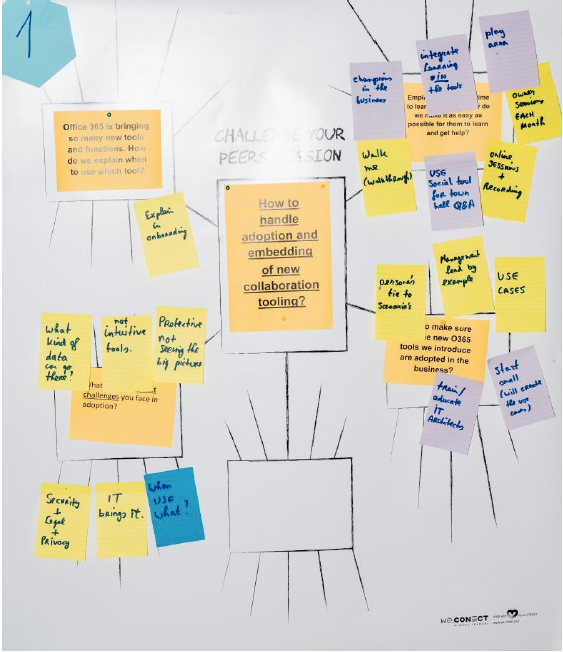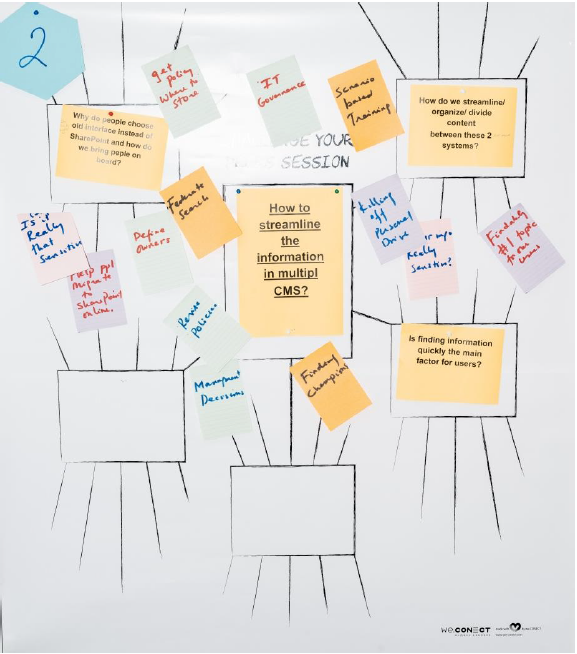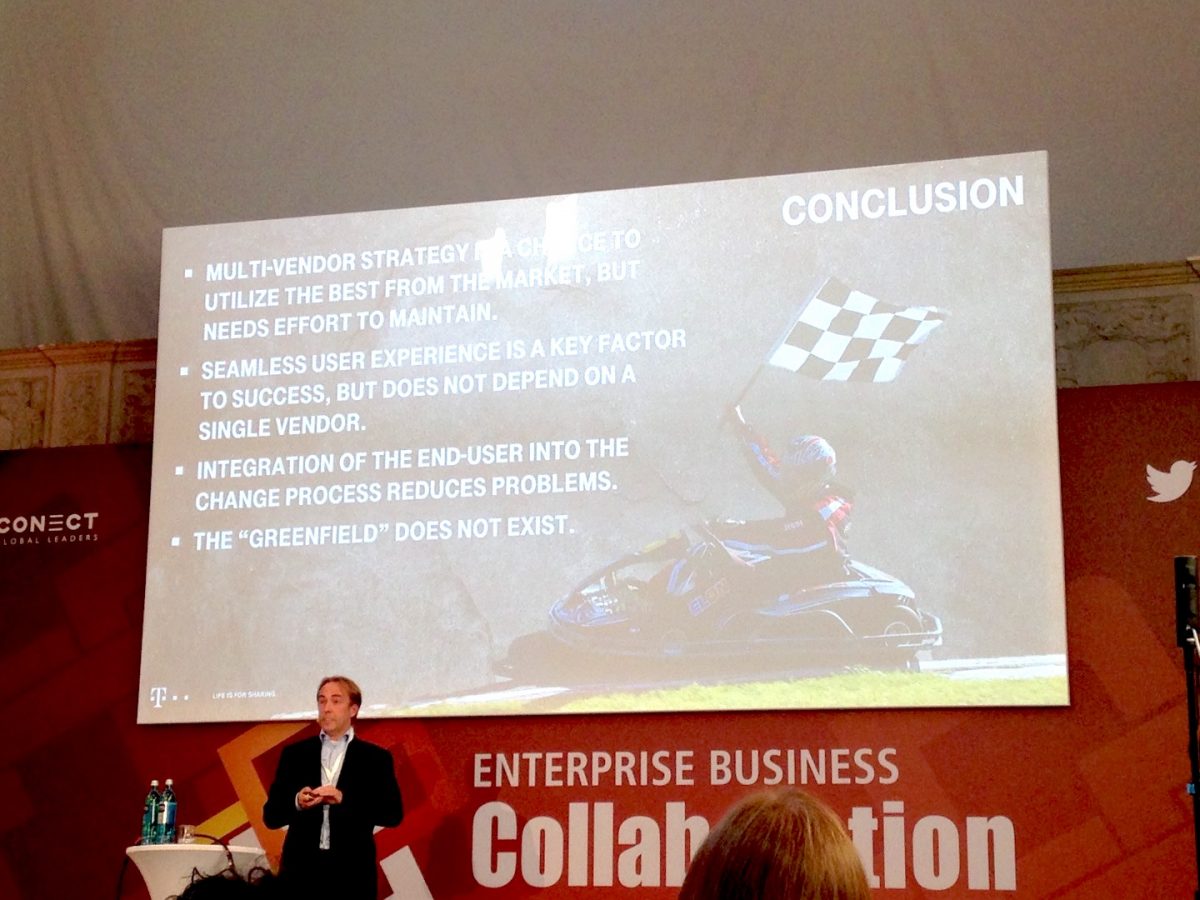SEE YOU AT THE POOL
The Enterprise Business Collaboration conference (EBC for short) took place this year September 18-19 at Stadtbad Oderberger in Berlin- that’s right- attendees sat directly above a swimming pool. (Stadtbad means Public Swimming Hall in German) The swimming hall originally opened in 1902 and has since been renovated to include a retractable floor above the pool, so conferences and other events can take place in the grand hall. The location suited the theme of changing technology in age old businesses.
Social Collaboration Past, Present and Future
Attendees from mid-size to enterprise corporations gathered to discuss social collaboration. Day One kicked off with conference chair Dr. Michal Tsur, Co-Founder, President & CMO at Kaltura Inc., who shared some insightful comparisons between previous years and this year’s EBC.
- Titles have changed from including technology and tools used, to ones reflecting values- a strong sign that organisations are updating their views on those working with social collaboration tools.
- In the past the conference focused on the why’s of social collaboration, but now so many companies have started their digitisation journeys that they can share their how’s with experiences and best practices.
All of the conference attendees agree that social collaboration and the tools that enable it are of great value, but how do you convince major decision makers in your company? Christian Heraty, Senior Consultant, Infocentric / Switzerland advised avoiding what he calls “the ROI trap,” ROI is sometimes falsely focused on cash, but it is actually about value. One way to help decision makers see this is to ask, “Would your employees miss the intranet if it was turned off?” Would you miss your desk if you came to work and it wasn’t there? Though the intranet isn’t physical, you probably wouldn’t be able to work without it. And of course one should always remember what the decision makers are interested in, after all they have a lot of the same problems as everybody else. So, keep your deck to 6 slides or less because everyone values their time.
An Ecosystem of Connectivity
Employees are continuously bombarded with tools like Sharepoint, Yammer, etc- which application do they use first, and how do they use it?Federico Casalegno Ph.D. Founder & Director at MIT Design Lab set the future scene in which services will live in an ecosystem of connectivity from day 1. Take for example a Tesla car: the owner has an app on their smartphone which they can use to turn on the car, and ask it to pull out of the garage. Of course the garage door needs to be opened first, so the owner can purchase an add-on for the app that communicates with the garage. What does this have to do with social collaboration? In a modern working environment tools should work harmoniously like the Tesla and the garage door. The real ins and outs of several softwares working together simultaneously should be cleaned up and offered in a simple and clear interface. If we dream a little harder, employees would only need to sign on once, the oh so enviable SSO.
Volker Mueller-Lausus, Vice President Workplace Services Telekom IT, Deutsche Telekom AG is working towards this dream for a multi-global company. Volker enables productivity by supporting digitization through a modern and mobile service portfolio. Though Telekom is streamlining their services, and using more functionalities from Office 365, Volker takes aBest of Breed approach on Telekom’s vendor strategy. He looks for vendors that offer high quality of service, integrate with other services, and allow SSO (single sign-on) authentication.
Roadblocks on the Journey
Once an intranet or social collaboration tool like ((Jive or Sharepoint/link both)) is established, you’ll have to work even harder to achieve a high adoption rate. At the “How to Handle Adoption and Embedding of New Collaboration Tooling” Round Table lead by Paul Leemans, Global head of Collaboration, ASML Netherlands BV / The Netherlands we found that most companies at the conference were experiencing similar pains while rolling out social collaboration tools. Challenges discussed included:
- Drop off after 15- 20% use
- Sharepoint being used as a shared drive
- Early adopters should support other users, but they don’t want to
- Many employees don’t see why they need new tools when they are used to using the old ones
- Employees are slow to adopt social learning
- Learning tools aren’t embedded in the social collaboration tools or intranet
Richard Bloomfield, Transformation Communication Leader, GE Corporate helped his company transform from a vertical company to a horizontal one, and they went through enormous change all at once. He offered his experiences to the convention, and shared GE’s roadmap to transformation. In order to define their journey they set up 30/60/90 day “Pulse Surveys” to work with management to see the results of their efforts, and found that there are 4 elements crucial to creating collaboration:
- Creating Watering Holes– your community will need resources where they can replenish and share knowledge
- they use Yammer and Sourcing.ge.com (their intranet)
- make sure to fill the watering hole with lots of content, and help
- Find and Celebrate Role Models
- Establish a Shared Operating Rhythm
- Transparent Metrics
- there should be a single source of truth where these can be found
- give teams scores on their adoption


Download PDF for more results or check the Enterprise Business Collaboration website.
Where Do We Go From Here?
In a way, many of the conference goers were comforted that they weren’t the only ones struggling to roll out social collaboration tools. Through many great presentations and shared experiences some conclusions were reached on the best practices:
- Find and use tools that integrate, so your employees can find everything in one place
- Take care to onboard and train properly
- Identify and reward early adopters, they’ll become your champions
- Make sure resources and support are easily accessible
- Define metrics that incentivise and prioritise using Social Collaboration

 About the author:
About the author:
Marisa joined Pokeshot in September 2017 to support the sales team. Her main activities include: expanding Pokeshot’s footprint in the Jive community, promoting SmarterPath in the German market and creating demand with new customers in Europe. Before Marisa joined Pokeshot, she completed her studies at UC San Diego focusing on Visual Arts and Management Science. Outside of the office, you can find Marisa performing weekly in improvisational theatre groups and occasionally as a stand-up comedian.
Connect with us on facebook | twitter | LinkedIn | YouTube – we will keep you posted!